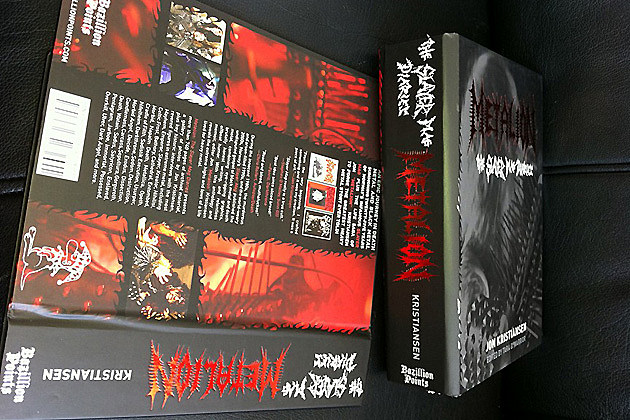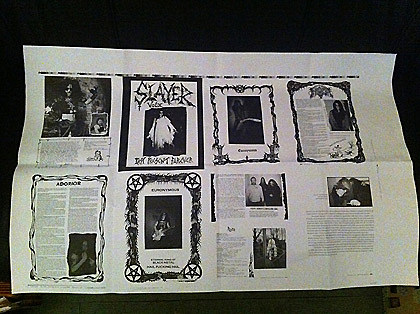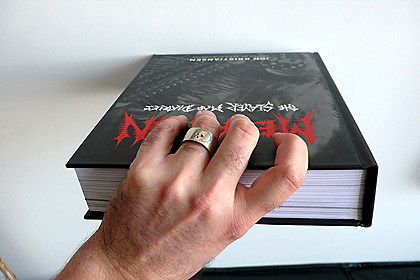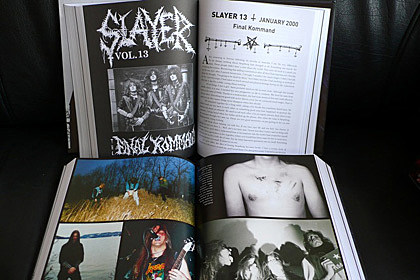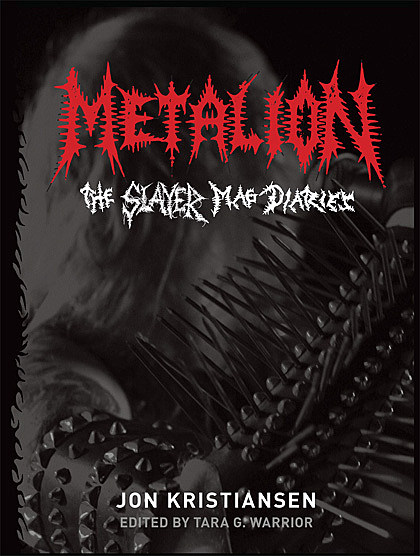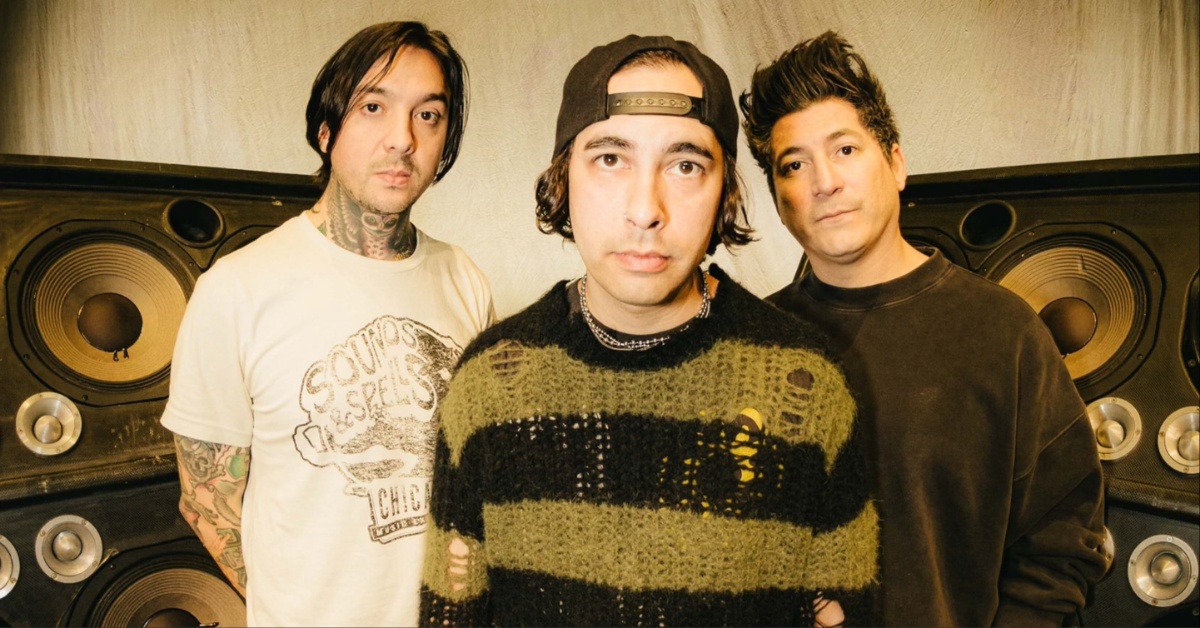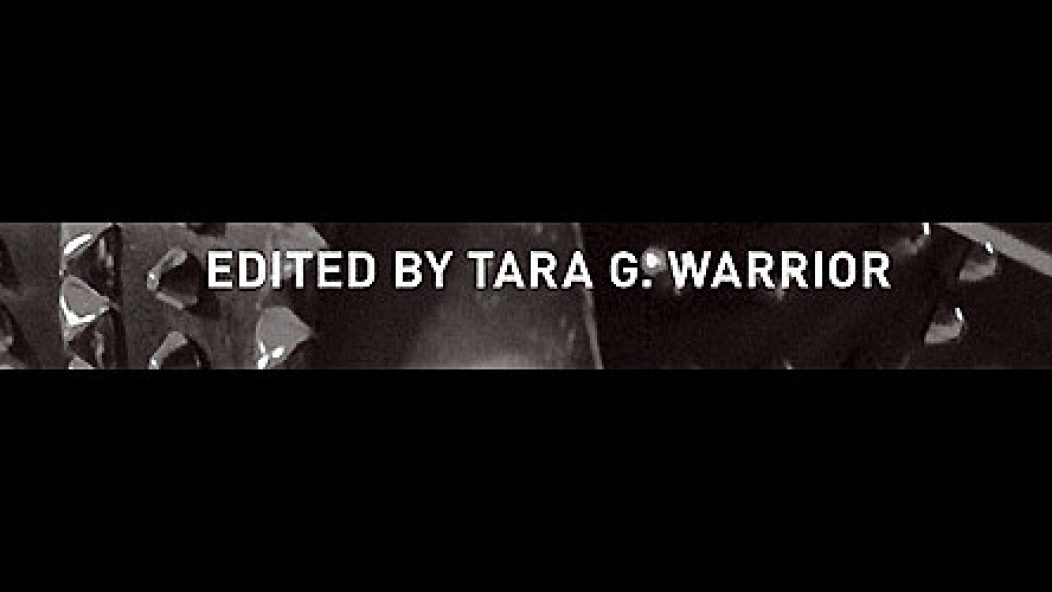
Interview: Tara G. Warrior
. . .
When legendary Norwegian zine editor Jon “Metalion” Kristiansen decided to publish an omnibus of his work, he realized he needed help. He didn’t want to just reproduce old zines; he would rather tell the story of his life in underground metal. Instead of tackling the project alone, he called longtime friend and occasional collaborator Tara G. Warrior, who wrote a black metal timeline for Peter Beste’s art book True Norwegian Black Metal. Warrior and Kristiansen started as pen pals and eventually became close friends.
Their goal was to write a coming-of-age story involving some of the most notorious figures in underground music. Warrior spent weeks with Kristiansen in his hometown of Sarpsborg, Norway. She recorded every conversation and scribbled notes for hours. The resulting memoir is layered between reproduced zines and rare photos in Metalion: The Slayer Mag Diaries, published by Bazillion Points. The writing process was long and sometimes painful; Warrior interviewed a confidante about the most challenging parts of his life. The hefty book (744 pages) was trimmed from more than 1,100 pages.
Michael Moynihan’s Lords of Chaos introduced the world to the black metal underground and popularized a then-subterranean musical genre. The Slayer Diaries accomplishes a more important task; it reveals the fallible people behind the legends, and shows how one insider managed to survive and evolve. Warrior talked to us about the daunting task of collaborating with Kristiansen on his life’s work.
. . .
My understanding is that you and Jon first bonded over The Allman Brothers?
We didn’t bond over black metal. We have a lot of common musical tastes. Slayer gets called a black metal magazine, but I’ve never seen it that way. It’s much more all-encompassing. You have to remember Jon’s work predates Slayer. He had a zine before that. He’s been at this for about 30 years. Black metal as people know it is a much younger phenomenon.
Jon had an older brother, and I had an older half-brother. That’s how we both got our music as kids. It trickled down. We both listened to the Stones and Beatles at first. We bonded over that experience. Everyone has written him and said, “Oh, you know Varg! Wow!” I wasn’t going to be that person. I wanted to talk to him about things that were more real and organic. And that was the music that first got us into music. He related immediately.
What compelled you to write Jon?
When we started writing (in 2001), it was a strange year. I’m a New Yorker, and of course everyone knows what happened. The year started out very lighthearted and became heavy. That’s kind of like Jon’s experiences with black metal. It’s something we talked about early, the way things change so unexpectedly. We just got along on a deep level very early. I don’t know if that has to do with the circumstances. Maybe it does?
Lords of Chaos was still a big book at that time, and I think he felt misrepresented. When I wrote Jon, I wrote 50 different letters at first. I thought he would never write back. I thought he was legendary, and I felt like I was making an ass of myself. I didn’t want to bore him by asking about church arson. So I said, “I want to know if you like The Allman Brothers?” It turns out that’s the reason he wrote back.
When you and Jon began writing each other was it via snail mail or email?
It was through email. I have complicated feeling about the Internet (laughs). I think it’s good and bad. It was great to meet someone like-minded and be able to chat online. We often wrote each other a few times a day. Jon feels like our correspondence was a throwback to the old days because we talked about everything. From the get-go, we talked about our lives and things that would be in letters in the past. It wasn’t just about demos. It was about the day-to-day stuff. Our correspondence became about these things very quickly, and music became less a part of the conversation.
What were his concerns with Lords of Chaos?
We talked about it when we did the interviews for Metalion. When he looks back at it, he feels pretty naïve. There are more books now about the metal underground than in the mid-1990s. Back then, there was nothing.
Lords of Chaos was basically it…
Jon said that when he was contacted, he didn’t grasp that this was going to get go big and follow him. How would you have any way of knowing that when you come from an underground world where things are Xeroxed and seem disposable? To go from that to a big glossy book seemed like a big leap, then. He didn’t expect it to happen.
He felt like he could have done a better job of representing himself properly. I don’t want to slam [Lords of Chaos]. I don’t like a lot of things about it, but it did open doors for books like ours. It was a big part of creating a viable niche market for a company like Bazillion Points. So that’s a good thing.
. . .
. . .
Was one of the issues Jon had with the book that people started to only care about him for friendships he had with people when they were teenagers? He knew people like Euronymous when they couldn’t play instruments.
I think a lot of people don’t really understand him or just see him as a novelty. It pisses me off. It makes me angrier than it makes him. They only see Metalion or Slayer magazine. They don’t seem to get that there’s a person there or look at what this person has been through. People mythologize arson and Varg and think it’s so cool. I’ll come right out and say Burzum is as popular as they are due to what happened. Black metal is as popular as it is in no small part because of what happened. People forget that Jon’s best friend was murdered in cold blood by someone he considered a close friend. Think about that happening to you.
When Jon asked me to participate (on the book), the reason was to help tell the other side of the story. He has a compelling story, even if you just talk about producing the zines. But there’s also a very human story. Jon’s story has classic literary themes like the loss of innocence. Anyone of my generation who has a hippie English teacher has heard about the loss of innocence.
A Separate Peace, Catcher in the Rye, Huck Finn – all of those books have that theme.
The greatest literary works center on it. I’m not saying we’ve come up with something like that. But Jon’s story has those universal elements. It was important and needed to be told. If one person reads this and understand that lives were affected and real horrible shit went down, and it wasn’t cool, then I’ve done my job.
In Jon’s story, Euronymous comes out as a more fully formed person, not just someone who wrote incendiary letters and boasted about arson. Does Jon feel like Euronymous has been lost in the picture, especially since Varg has been paroled and resumed his musical career?
With all of the mythology surrounding these things, I think people have lost a sense of Jon as a human being and Øystein (Aarseth) as a human being. Jon told me that many times throughout our friendship and when we were doing the book. He felt like people had forgotten Øystein.
I don’t read many interviews with Varg. I’ve never met him. What I know about him is what I know from Jon and what I’ve read. He’s not a person I would want to know. There are two ways to look at it. Either you are completely sociopathic or a posturing asshole or maybe a combination. We’re talking about murder. It’s not a way to market your record. It’s not something decent human beings do. The fact that it’s been 20 years, and he still seems to be playing this role, it’s like he’s trying to act superior. But what’s so superior about staying in the same place for two decades? He talks about being weak, but what is more weak than not evolving?
Jon’s story makes me think about SE Hinton’s The Outsiders, where these misfit kids have dreams and aspirations and don’t fit in. Then something horrible happens, and their entire world changes.
I never thought of this in terms of The Outsiders, but it fits. Jon is the one person who has stayed gold. If you want to put it in those terms, he’s more gold than anyone I know. He has this way of observing people that’s almost childlike. He sees exactly what’s there. He manages to not filter it through any agenda, which is so hard. He can observe things so purely. It amazes me. It comes through in the photography he does now.
. . .
. . .
How did you first start collaborating with Jon?
Peter Beste put out his photo book in 2008. It was probably November or December of that year when he got in touch with Jon and said he needed written content to make the book work. It’s an art book, of course, and many people who pick it up might just be into photography. There needed to be more. Jon wrote a fantastic piece about the history of Norwegian black metal. Peter asked me to compile a timeline of Norwegian black metal. Not long after that Ian Christe called. Swedish Death Metal was published, and he sent Jon a note that said, “What do you think about a Slayer book?”
Jon got the note and contacted me and told me to see Ian. He thought it was a good idea but didn’t want to just reproduce zines. He wanted me to collaborate. We went from there. We quickly decided on the diary format. I decided interviewing him was the best way to do it. I went to Sarpsborg, and we just did intense interviews. I went twice, and we did nothing but interviews for a week straight. It was like boot camp.
After then you worked to craft his biographical sections?
Yes. What we needed to do was weave the zines around the biographical stuff and pick the best of it, see what worked best with the story. There was a lot to wade through (laughs).
A lot of the work was creating a story arc out of some disparate elements like interviews, letters and zines?
The idea from day one was that we wanted a narrative. It was important to both of us that anyone be able to read this book, not just the uber-kvlt. We wanted it to appeal to casual fans or people into other aspects of the underground. I wanted to make it as accessible as possible. It was tough to be concise, to make sure we were clear enough for readers that might come to this as an unknown entity.
What was the biggest challenge of the project outside of length?
The intensely personal nature of the interviews. Jon and I were already quite close, and he didn’t tell me things I hadn’t heard. But there were things that we talked about or even got on tape that were things he’d never told anyone else. When it came time to edit, and we looked at the book, it was like, “Wow, do we want to go here?”
Maybe it’s because I’m older, and we’re not part of a generation that thinks anything should be put out for consumption. But there were things that might have been too personal or private. Some of the places we went doing this book were very hard. The things I was asking him to go on record about were difficult. I didn’t want to traumatize my friend, but I also had to sit him down and ask him what it was like when he arrived at the old Mayhem house and saw his friend’s brains on the wall. It’s a tough question to ask someone you care about, and it’s tougher to push them to answer it. There were murky waters.
. . .
. . .
It’s tough to be so close to someone but also do your job as a journalist.
There were times when Jon literally got up and walked out. We eventually got it all, but it was a grueling process. In the course of an ordinary friendship, you don’t push people to talk about things when they don’t want to talk about. Jon has also talked about them before and wasn’t pleased with the results. I know he trusted me, and that was the idea of involving me with the project. But it put me in the position of having to do a job. I had to produce something people would want to read. There was no point in putting this book out without addressing these things. We can’t do this book without talking about arson, murder, and suicide. It’s a huge part of the story. During the final edits, Jon took a few things out that I thought were very powerful. He knew they were important in terms of the story, but it’s his life, and he has to live with whatever was released.
How did you get into writing and editing?
This isn’t my day job, but who knows what will happen. I’ve wanted to write for a long time. At first I told Jon I didn’t have much of a track record. Bazillion has a proven track record, and Jon does, too. I’m honored and flattered that he insisted I work on the book. After all this work, I’m not sure I want to write about metal again (laughs).
One thing that amazed me is that Jon thinks he’s written something like 30,000 letters in his life. He spends a lot of time alone, but all of that writing seems to indicate a longing for human connections.
He’s a man of many, many contradictions. It’s one of the reasons he’s so compelling. He’s not a social guy, and yet he’s written all of these letters. I’m not very social, either, so we’re the same in that respect. But the sheer amount of people he’s written and contacted is staggering. Part of it is just the set of circumstances. He complains a lot about the place he’s from in Norway. It reminds me of an old steel town in Pennsylvania or Ohio. The whole way of life is based around a certain industry, and that’s what people do. Most people never leave. It can be a pretty suffocating existence. His way of dealing with it was to reach out as far as he could.
. . .
. . .
BUY METALION: THE SLAYER MAG DIARIES
. . .
